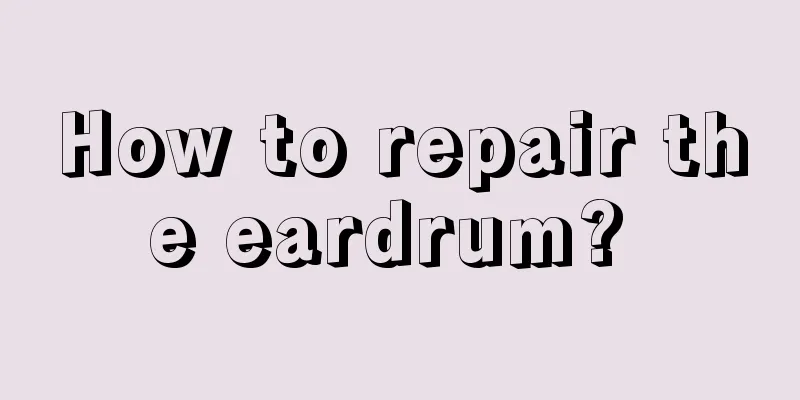How to repair the eardrum?

|
The ear is a tool for people to receive information. Its components are relatively complex, consisting of two major parts: the auricle on the outside and the ear canal on the inside. At the end of the internal ear canal is the eardrum, which is the processing center that receives sound and converts it into information that can be recognized by brain cells. Therefore, the importance of the eardrum is self-evident. Although the eardrum is inside the ear canal, it can be damaged in certain situations, such as bath water entering the ear, sharp objects piercing the eardrum, etc., which are common phenomena in life. If the degree of injury to the eardrum is minor, it can be repaired by medical means. Let’s take a look at how to repair the eardrum. When the eardrum is perforated due to external pressure, puncture, inflammation, etc., it is like a broken drum that no longer makes any sound, and people can no longer hear any sound. After the eardrum is perforated, the middle ear tissue will undergo inflammatory pathological changes and will also be susceptible to infection by external bacteria. Therefore, the best approach is to repair the eardrum, which is called tympanostomy. (I) Cauterization Suitable for small eardrum perforations 1. Apply a cotton pad soaked in 2% tetracaine solution to the remaining surface of the tympanic membrane for 15-20 minutes. 2. Use a small cotton swab dipped in 0.1% thimerosal tincture or 70% ethanol to disinfect the external auditory canal and the remaining tympanic membrane. Be sure not to allow the disinfectant to overflow into the tympanic cavity. 3. Use a fine probe to make a small cotton swab, dip it in 50% trichloroacetic acid solution, and carefully apply it to the edge of the perforation to create a 0.5-1.0mm white burning circle at the edge of the perforation. The purpose is to remove the epithelium and scar at the edge of the perforation and promote the regeneration of the eardrum. After cauterization, apply a thin cotton pad containing 5% urea solution to promote the growth of the perforated tympanic membrane. After the operation, 5% urea solution was dripped 3 times a day. The cotton pad was removed after 1 week. If the perforation failed to close, it could be cauterized again until it closed. The cauterization method often needs to be repeated several times, and you should be patient and persist. (II) Scrape and stick method For smaller eardrum perforations 1. Apply a 2% tetracaine wet cotton pad to the remaining tympanic membrane for 15-20 minutes. 2. Disinfect the external auditory canal and the surface of the tympanic membrane with a cotton swab soaked in 0.1% thimerosal tincture or 70% ethanol. 3. Use a thin needle to scrape off the epithelium at the edge of the perforation and the epithelium 1-2mm away from the edge of the perforation. It can reach the fibrous layer of the tympanic membrane but cannot penetrate it. After the operation, a thin cotton pad soaked in 5% urea solution can be applied. Thereafter, 5% urea solution should be dripped three times a day to promote the growth of the tympanic membrane. Remove the cotton pad after 1 week. If the perforation fails to close, repeat the above operation until the eardrum heals. |
>>: How to treat facial burns?
Recommend
What are the dangers of drinking carbonated drinks frequently
With the improvement of living standards, various...
What are the precautions for patients with ovarian tumors
After the occurrence of diseases such as ovarian ...
What's the matter with soreness and weakness in the joints of the limbs
When symptoms of soreness and weakness in the lim...
What does HPV18 positive mean
HPV18 virus is a relatively common HIV virus. It ...
What are the small bumps in the groin
Our body is a complete and independent individual...
How to measure blood pressure more accurately
Blood pressure is an important health indicator o...
What happens if kidney deficiency becomes serious
Nowadays, the pace of life is fast. Although the ...
Lymphoma patients may suffer from psychological illness, please pay attention to counseling
The treatment of lymphoma is not just about medic...
Can you drink expired beer?
Beer is more popular in the summer because it not...
How to clean oil stains on clothes
When clothes are stained with oil, we will be par...
Symptoms of colon cancer that everyone needs to be aware of
Although the incidence of colon cancer is relativ...
How long does it take for a person with renal cancer bone metastasis to live
Nephrologists say that renal cell carcinoma ranks...
How to diagnose breast cancer bone metastasis
Bone metastasis is common in breast cancer patien...
Yogurt Mask 8 rare beauty methods of yogurt!
1. Yogurt detoxification and weight loss method H...
Which hospital should I go to for follow-up examination after cervical cancer surgery
Which hospital should I go to for a follow-up aft...









